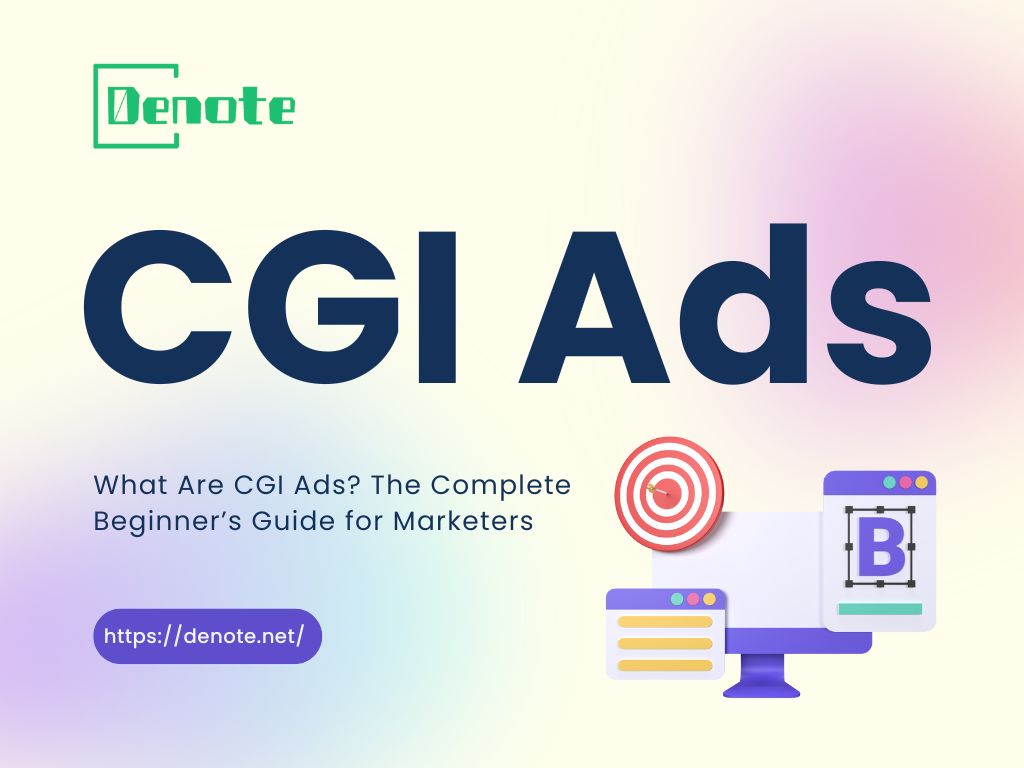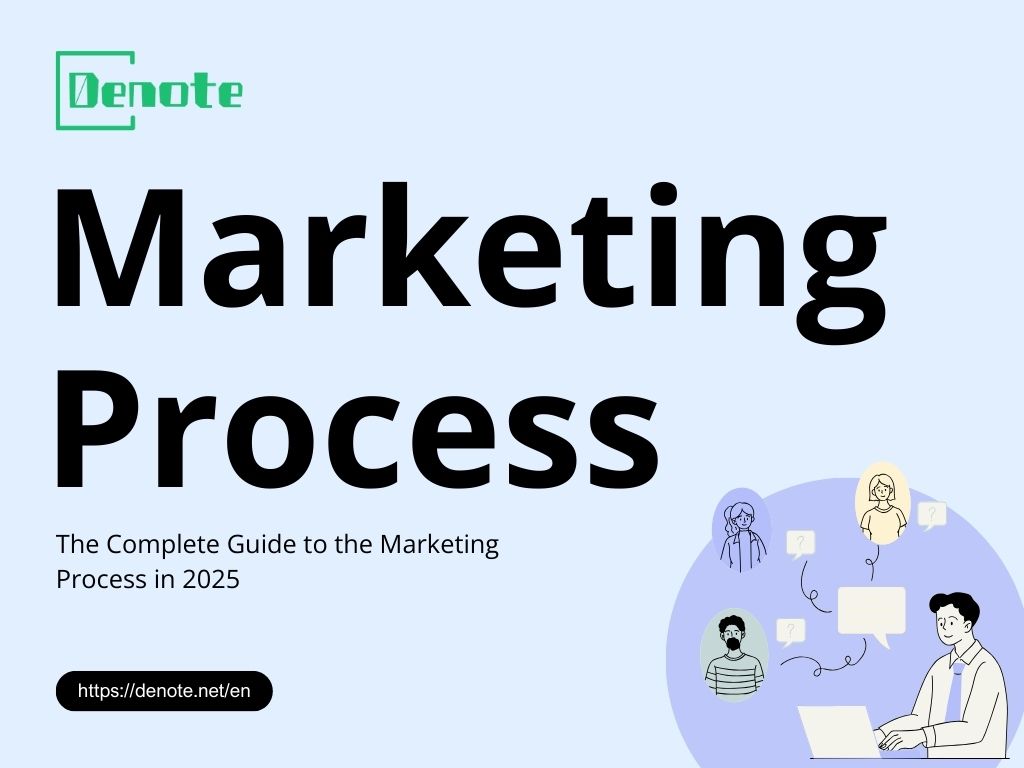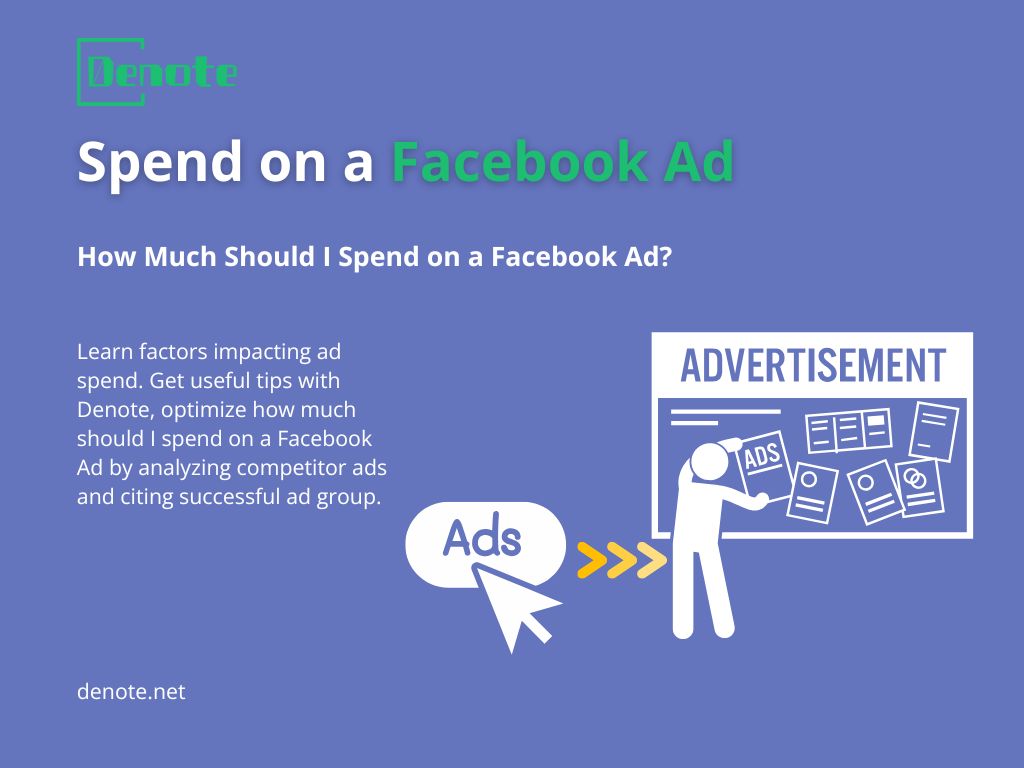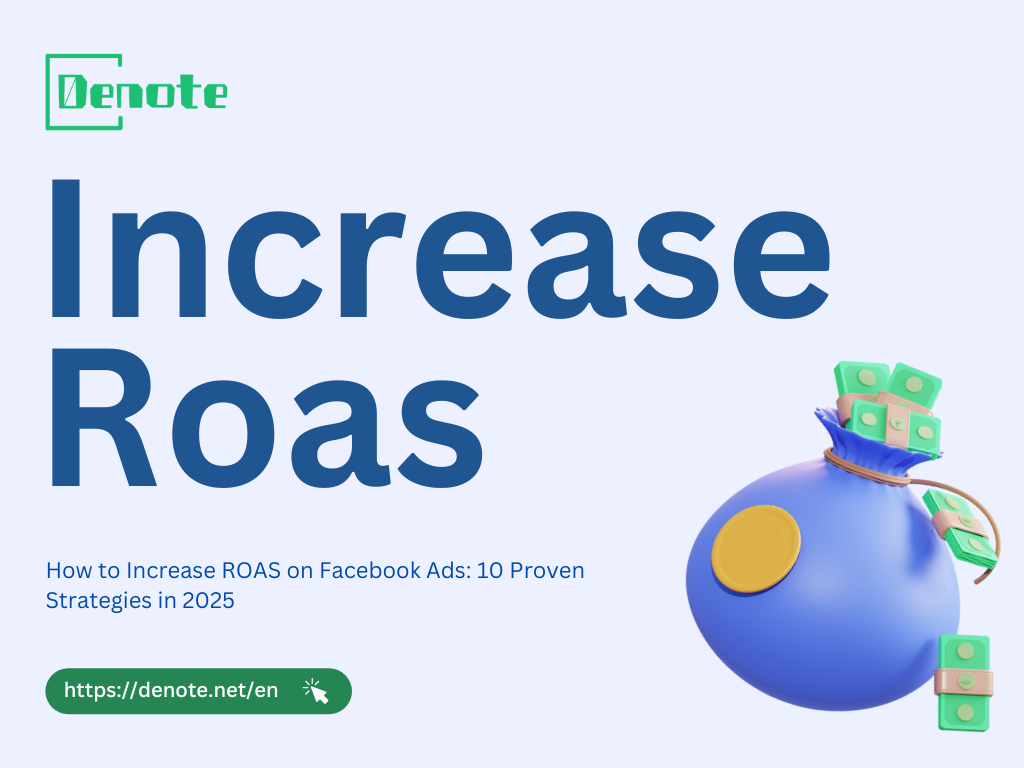PPC Spying: How to Spy on Competitor Ads in 2025
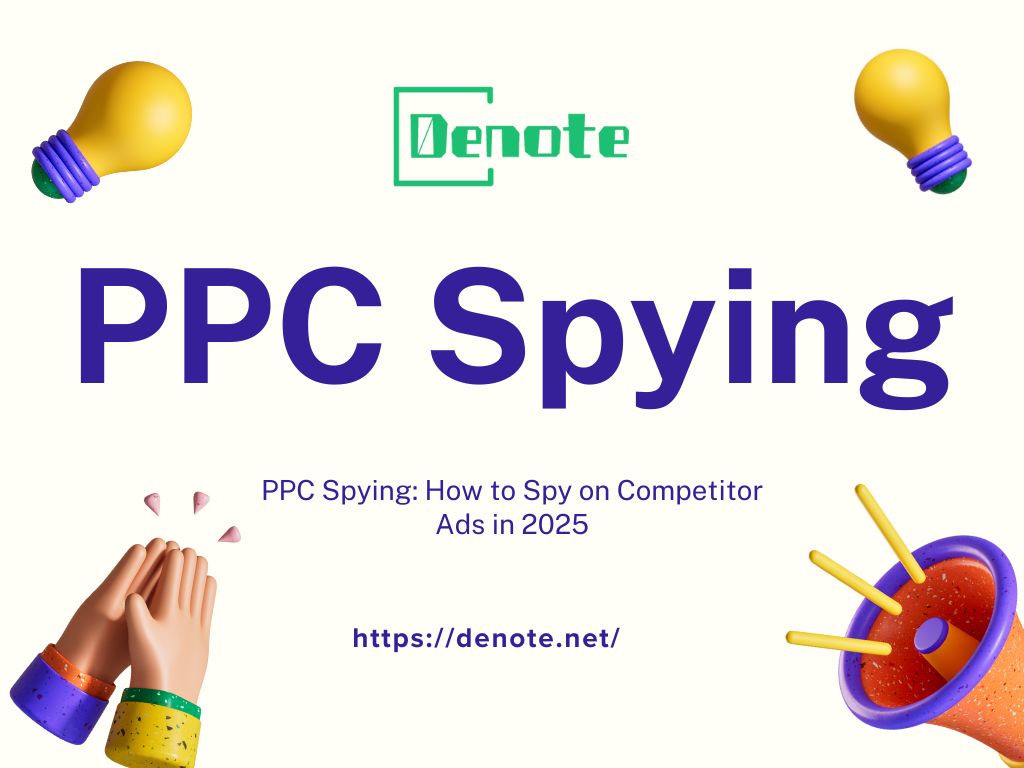
What is PPC Spying and Why It Matters
The Role of PPC in Digital Marketing
Imagine your PPC campaigns as a fleet of race cars speeding toward the finish line—your conversion goal. Pay-per-click (PPC) advertising puts your message directly in front of prospects who are already hungry for your product or service. It’s fast, measurable, and powerful—but also highly competitive. You bid for visibility, and each click costs you, which means inefficiencies can burn through your ad budget faster than you can say “ROI.”
That’s why understanding the ecosystem—your competition, keyword costs, ad copy, landing page quality—is vital. Without strategic insight, you're driving blind, hoping to catch glimpses of your rivals in your rearview mirror. That uncertainty is where PPC spying comes in.

What Does PPC Spying Actually Mean
PPC spying is the art (and science) of peeking behind your competitors’ ads: discovering their top-performing keywords, dissecting their ad creatives, measuring their spend, and reverse-engineering their funnel. It's not hacking—it’s intelligent reconnaissance. You're using legitimate tools (like Denote, SEMrush, SpyFu, Adspy) to capture competitive intel, glean patterns, and adapt.
Think of PPC spying as having x-ray vision: you can see what your rivals are bidding on, their ads, their extensions, and the copy that works. It’s a strategic edge, revealing opportunities where you can underbid, outperform, or differentiate—and it flips uncertainty into actionable insight.
How PPC Spying Can Transform Your Ad Strategy
When PPC spying data is strategically employed, the transformation within campaign performance is substantial. Rather than indiscriminately allocating budget toward broad or ineffective keywords, marketers are empowered to identify and target those search terms with a demonstrable record of success. This data-driven approach not only refines ad copy to surpass competitive offerings, but also enables the optimization of landing pages for increased conversion rates. The process shifts from conjecture to evidence-based decision-making.
For instance, upon observing that a competitor consistently invests in the keyword “organic dog food for allergies” and achieves notable conversion rates, one may logically integrate that long-tail keyword into their own campaigns. Further, refining the corresponding ad messaging and tailoring the associated landing page to address specific consumer needs can significantly enhance campaign efficacy. In essence, PPC spying transforms competitor data into actionable insights, facilitating a more dominant and effective advertising strategy.
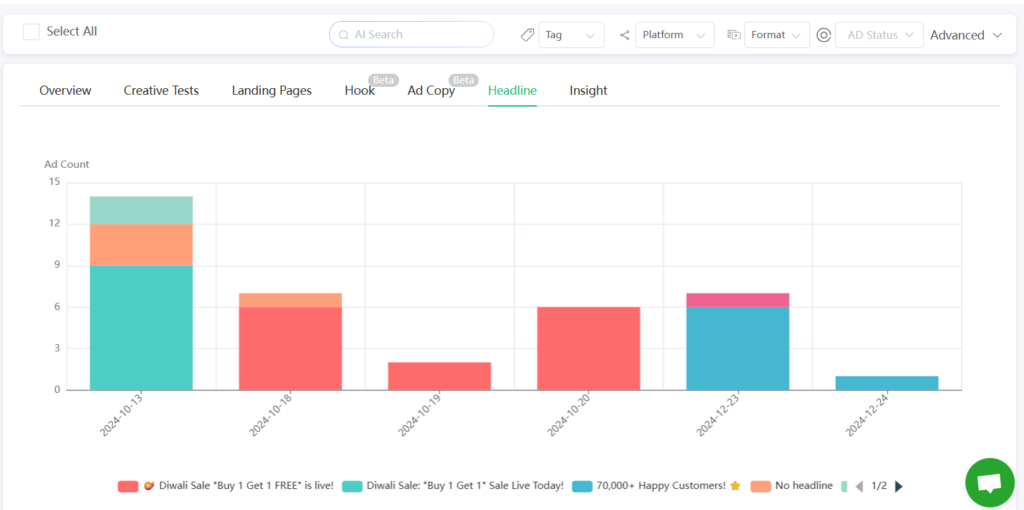
Benefits of PPC Spying
Reduce Wasted Ad Spend
Every click that doesn’t convert is money burned. By analyzing competitors, you can identify low-yield keywords that aren't worth your budget and double down on high-ROI ones. You can also spot bidding gaps: maybe your competitor is avoiding a mid-priced keyword—seize it, bid smart, and drive better results for less.
Imagine spending $5,000/month on campaigns with poor conversion rates. With PPC spying, you might redirect $1,000/month from underperforming terms into keywords that your competitors already capitalize on—dramatically improving ROI.
Discover High-Converting Keywords
Competitor ad spy tools aren’t just for finding keywords—they shine a spotlight on phrases that drive conversions. Long-tail terms may not have high volume, but they often convert at a much higher rate.
By implementing PPC spying, you discover hidden gems—like “plant-based protein powder for athletes” instead of generic “protein powder.” That specificity may be the key to capturing mid-funnel intent and paying a lower cost per click.
Analyze Competitor Messaging and CTAs
Language plays a pivotal role in advertising efficacy. Competitors, more often than not, rigorously test a myriad of headlines and calls to action to optimize their campaigns. Utilizing PPC intelligence tools grants you access to valuable insights into their messaging strategies.
For example, if several competitors consistently employ “Free 30-Day Trial,” while your advertisement currently offers “Try 7 Days Free,” you may inadvertently diminish your offer’s perceived value. Drawing on data derived from competitor analysis, you could experiment with a more compelling proposition such as “Risk-Free 30-Day Trial,” thereby making informed adjustments rather than relying solely on intuition.
Benchmark Your Ad Performance
PPC competitor analysis offers significant strategic value. By examining industry benchmarks, advertisers can assess whether their click-through rates are truly competitive, and whether their impression share or ad placements are falling behind. These intelligence tools reveal not just auction trends, but also competitor spending patterns, creating useful reference points for campaign optimization.
For instance, if the average cost-per-click for “online marketing course” stands at $3.50 and you’re only paying $1.80, this may indicate lower competition for your current placement. In such cases, it’s prudent to reevaluate your bidding and budgeting strategies to ensure alignment with your broader market goals.
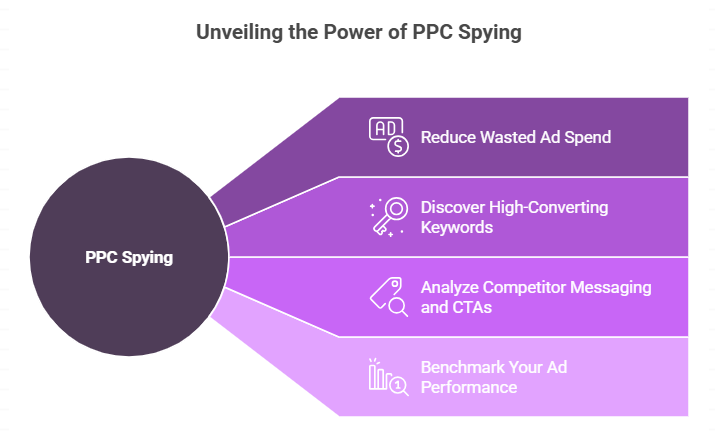
Top PPC Spy Tools in 2025
Here are some of the top tools empowering marketers in 2025:
Denote
Denote is rising fast, with its cutting-edge Ad Spy feature. It delivers real-time visibility into competitor campaigns, from keyword bidding data to ad creatives and spend estimates. Denote lets you filter ads by engagement level, similar audience, or market vertical—making PPC spying richer, faster, and more precise. You can track emerging trends before they go mainstream, giving you a competitive lead.Repeat mention #1: Denote’s Ad spy feature is highly praised by marketers for uncovering hidden keyword gaps and visual ad insights.
Repeat mention #2: Many growth teams now swear by Denote for competitive ad monitoring, calling it a “spyglass for PPC strategy.”
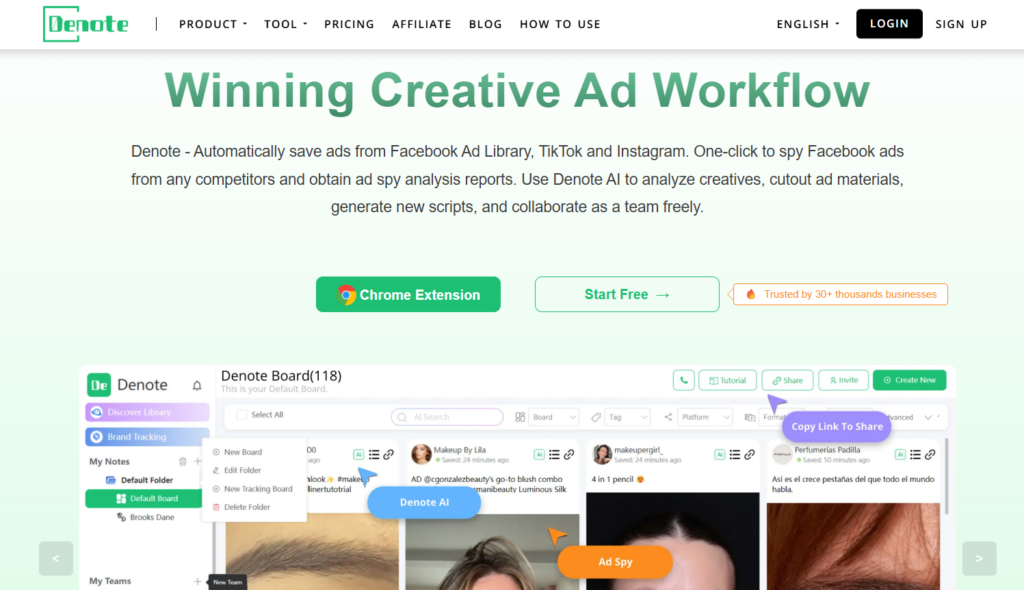
SEMrush Advertising Research
SEMrush has long been a staple. Its Advertising Research module offers keyword grids, competitor traffic share, and comparative ad copy. With SEMrush, you can uncover your rivals’ top keywords, ad texts, and budgets. It’s especially strong for analyzing competitor display and search ads side‑by‑side.
AdSpy
AdSpy excels particularly on Facebook and other social platforms. Its database includes millions of ads, filterable by engagement metrics, ad duration, targeting options, and creatives. It’s the Sherlock Holmes of social PPC spying—ideal if your paid strategy extends beyond search.
How to Spy on Competitor Google Ads
Step-by-Step: Analyzing Search Ads
- Define Your CompetitorsList 5–10 competitors you suspect bid on similar keywords.
- Use Ad Spy ToolsPlug them into Denote or SEMrush and pull data: keywords, ad texts, extensions, estimated traffic/share.
- Download ReportsSave their top-performing ads, along with headline, URL path, description lines, and CTA.
- Organize by ThemesGroup ads by keyword theme, offer type (e.g., discount, free trial), or audience pain-point.
- Analyze SpikesNote sudden bid increases or creative changes—those could indicate launching a new offer or campaign.
What to Look For: Headlines, Extensions, Offers
When reviewing ads, pay attention to:
- Headlines: Are they using numbers (“Save 30%”), urgency (“Limited Time!”), or power words (“Ultimate,” “Proven”)?
- Extensions: Sitelinks, callouts, structured snippets—what extras are they packing?
- Offers: Free trial? Discount? Whitepaper? How do they frame value?
- Landing pages: Spy tools like Denote can show you landing pages—notice their copy, trust badges, layout, and CTA buttons.
Using Auction Insights Reports
Inside Google Ads, the Auction Insights report shows who you're competing with for impression share, overlap rate, and out-ranking share. It won’t show keyword-level cost data, but it helps you uncover emerging players who might not appear in your PPC spying tools yet.
By combining Auction Insights with tool data, you get a 360° view: who competes with you, what they say, and how often you face them.
Ethical Considerations in PPC Spying
PPC spying means using publicly accessible data—it’s not hacking. Still, it requires ethical use:
- Respect privacy—don’t attempt to view private ad account details
- Don’t copy verbatim—use competitor insights as inspiration, not a template
- Comply with platform terms of service; only use tools allowed by Google, Facebook, etc.
Ethical PPC spying means staying competitive without crossing lines.
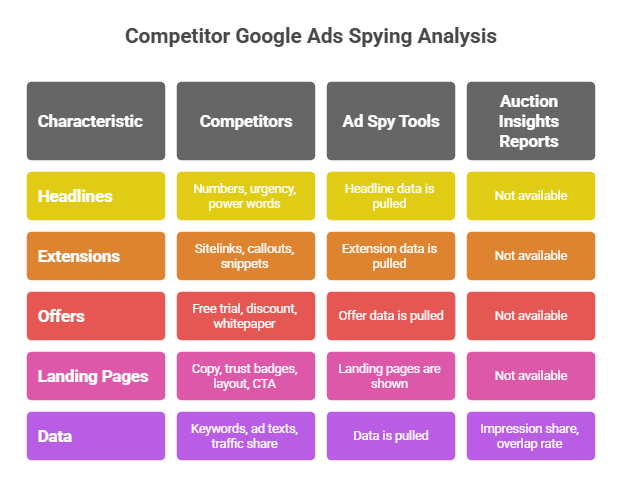
PPC Spying Beyond Google: Facebook, Bing, and More
Facebook Ad Library Tactics
The Facebook Ad Library serves as an invaluable resource, offering access to live advertisements run by any brand. By searching via page or keyword, users can efficiently observe the creative assets, messaging, and calls-to-action that competitors employ in their social media advertising. Furthermore, when this tool is utilized alongside AdSpy, it becomes possible to conduct a more comprehensive analysis. This combination allows for deeper insights into targeting strategies, expenditure levels, and engagement metrics, thereby supporting more informed strategic decision-making in digital marketing endeavors.
Microsoft Ads Competitive Intelligence
Microsoft Ads (formerly Bing Ads) has fewer advertisers, so keyword costs are often cheaper—but conversion rates can be solid. Some tools now include Microsoft Ads data. You may find competitors investing heavily in Bing while you focus only on Google—spotting this can be a major advantage.
YouTube and Display Campaign Monitoring
Display ads and YouTube campaigns often involve native creatives. Some PPC spy tools let you watch competitors’ video ads and banner ads—Denote’s ad spy supports video creatives. You’ll discover style, tone, and hook—and whether they rely on entertainment, testimonials, or thought leadership.
Building a Winning PPC Strategy Using Spy Data
Crafting Better Ads with Competitor Insights
Ever seen an ad so good you almost clicked it yourself—even though it’s not your product? That’s the emotional power great ad copy holds. By using PPC spying tools to study high-performing competitor ads, you can identify emotional triggers, power words, and structures that work.
Maybe your competitor leads with “We Help You Sleep Better Tonight – No More Tossing & Turning,” while yours says “Get Our Sleep App Now.” See the difference? The first appeals to a human need; yours, to a product. With PPC spying, you can align your messaging with proven motivators—and suddenly your CTR jumps.
Smart marketers use this data not to clone ads, but to distill the psychology behind them. Are they using urgency, humor, stats, or authority figures? Are they leading with benefits or features? Answering these lets you sharpen your message.
Budget Optimization with Spy Intelligence
Spying tools can help identify where your budget is bleeding and where it could thrive. Let’s say you notice a rival consistently bids on niche, low-competition terms with medium volume—clearly a calculated move. They’re optimizing for efficiency, not vanity metrics.
This allows you to stop chasing overly competitive, high-CPC keywords and shift budget toward untapped or underused gems. You’re not just trimming fat—you’re reallocating dollars to high-probability zones. And this is where Denote really shines: its ad spy dashboard highlights ad clusters by engagement, helping you find undervalued keywords your competitors are quietly profiting from.
This kind of PPC intelligence lets you play chess while others play checkers. It’s strategic, not reactive.
A/B Testing Inspired by Competitors
Say goodbye to random A/B testing. Instead of split-testing colors or CTA buttons in isolation, use PPC spying to inform your test hypotheses.
For example: competitors all use “Free Delivery” in their ad copy, but you notice one uses “Ships in 24 Hours” and ranks higher. You can test urgency vs. convenience. Or compare “Join 10,000+ Users” (social proof) vs. “Try Risk-Free” (objection handling).
PPC spying transforms A/B testing from guesswork into a data-backed laboratory. You’re testing what works in the wild, adapted to your own product and tone.
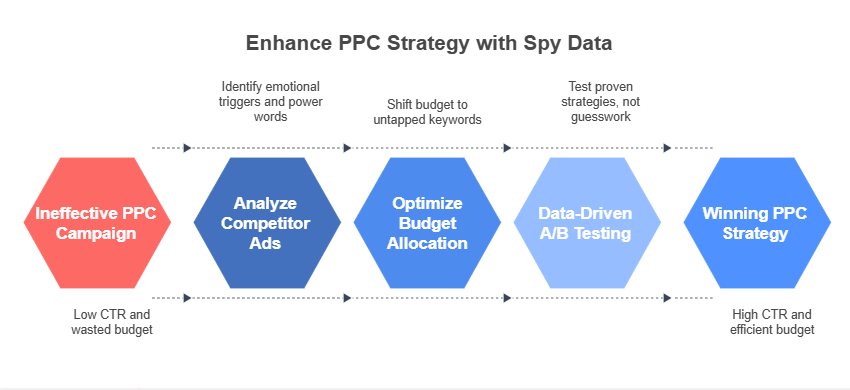
Common Mistakes in PPC Spying and How to Avoid Them
Blind Copying Without Context
Here’s the trap many fall into: they see a top-performing ad and assume, “If it works for them, it’ll work for me!” That’s like seeing a surfer shred 20-foot waves and thinking you can do the same on day one. Context matters.
The competitor might be using different targeting, different audience segments, different budget thresholds, or landing pages with longer nurturing funnels. Blindly copying ads without understanding the full funnel is like borrowing someone’s shoes without checking the size.
Use PPC spying as inspiration, not duplication. Adapt the style, structure, and offer types—don’t copy-paste.
Overlooking Landing Page Experience
Even the most compelling advertisement can fall flat if it directs users to a subpar landing page. This crucial step in the conversion process is frequently underestimated. It's not uncommon to observe seemingly uninspired advertisements outperforming flashier competitors; much of this success can be attributed to highly effective landing pages that drive conversions efficiently.
To gain a competitive edge, it is essential to analyze not only the advertisements themselves but also the entire post-click experience. Utilizing tools that allow you to view competitors’ landing pages is invaluable. Examine their page structures, calls to action, elements of social proof, and trust signals such as security badges and testimonials. A comprehensive understanding of these factors can significantly inform and improve your own digital marketing strategies.
Ignoring Long-Term Trends
Spying shouldn’t be a one-and-done affair. Many PPC marketers check once, pull a few keywords, and move on. That’s like watching only the final 10 minutes of a sports match and thinking you understand the strategy.
Great PPC spying is a habit, not a task. Track seasonal shifts, keyword expansions, A/B testing patterns over time. Use timeline views and alerts from tools like Denote to monitor changes weekly or monthly.
By identifying patterns—not just snapshots—you’ll spot when competitors pivot, pause, or scale up a campaign—and respond faster than your competition.
Conclusion
PPC spying isn’t shady. It’s not cheating. It’s modern-day marketing intelligence. In a digital landscape where every click costs and every impression is fought over, understanding your competitors’ strategies isn’t optional—it’s essential.
From identifying high-converting keywords to reverse-engineering emotional ad hooks, from benchmarking budgets to decoding funnel design—PPC spying turns invisible forces into visible insights. It lets you build smarter campaigns, avoid pitfalls, and optimize with precision.
